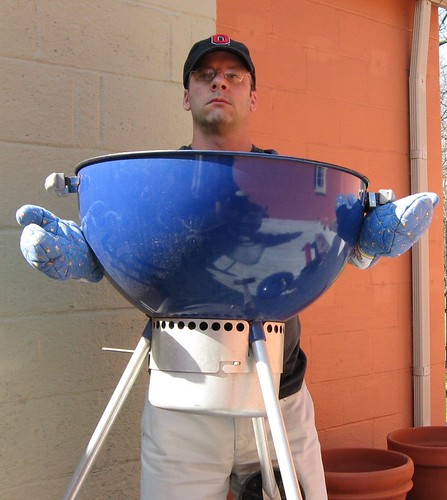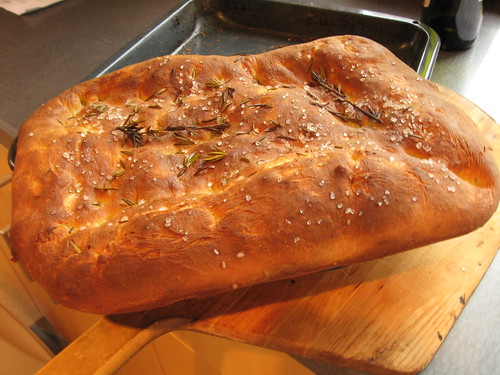
I like bread machines for kneading dough. I had my last one about 10 years and never baked a bread in it, although I used it about 2 times a week. I used it as dedicated equipment for kneading. Don't have to clean the bowl when finished and it works tirelessly. It can also be programmed to pop out your pizza dough as you come in the house. When I tried using it to knead a lump of pasta dough, I destroyed it. Pasta dough can be pretty tough. Another failed experiment in the culinary sciences.
Recently, I bought some type 00 flour. I used King Arthur's brand, which is milled in the states to the same specifications of its Italian counterpart. Type 00 is milled to very fine particle size. The resulting bread doughs are very stretchy and particularly good for wafer thin pizza. The only downside I've noticed is bread dough derived from it tends to be a bit sticky. Sticky dough, in the early stages of kneading, can cause one to add too much flour and create too dry a dough.
One way around a sticky dough is to use a bread machine. The dough cycles on these things are long and efficient. You can watch the dough pass from a slack, sticky mess into a more developed, resilient dough without adding any additional flour.
For this focaccia, I used 1/2 unbleached white (225 g) and 1/2 type 00 (225 g). The rest of the ingredients are about the same as my pizza dough. Liquid used was water (150 g) and milk (150 g), honey (20 g), salt (7 g), instant active dry yeast (1 packet) and let the dough cycle take over. 1.5 hours later, I popped it out, squashed it down for a 10 minute rest and then formed it into a 10"x14" (or so) rectangle on a dark, porcelain covered steel pan, covered it in olive oil, speckled with coarse salt and added rosemary and let it proof about 20 minutes. I docked the surface with my fingers and baked it (425F convection) for 30 minutes (oops, about 5 minutes too long). It had a beautifully light interior. I was kicking myself for overcooking it but am inspired to repeat it.
I'll give a link for the type 00 flour, it's not too expensive - even with shipping. Comes in 2 lb bags and also can be purchased at Carfagna's.
4.23.2008
Focaccia: Type 00/Unbleached White Flour, Kneaded
4.18.2008
Evaporated Cane Juice vs. Granulated Sugar
After reading Kashi's apple bake recipe using evaporated cane juice, I was so angry, I had to do about 5 consecutive sun salutations to manage my anger. Evaporated cane juice and plain old sugar are unequivocally the same, α-D-fructofuranosyl β-D-glucopyranoside (aka, sucrose, table sugar). After studying a while, the only difference in the processes used to isolate these substances on an industrial scale is one goes through one processing step more than the other. That's it. Same crop, same molecule. The white granulated sugar requires more energy to produce. So, it should be more expensive, tougher on resources and more expensive to produce. However, it costs less than evaporated cane juice, because people want what sounds "natural", regardless of the truth. Domino wins.
The subtle difference in composition between the two is simply the evaporated cane juice (ECJ) has a teeny bit more vitamin A, C and calcium (in a 100 grams sample). Take a vitamin. Lots cheaper.
In the industry, substances are produced according to specifications. Each batch produced is analyzed to insure compliance with the specifications. Documentation of this analysis comes in the form of a certificate of analysis (CoA). These are available to compliance agencies and geeks who really want to know weird information. I emailed DominoSugar.com today to try to get a typical CoA for granulated white and ECJ (their product name for ECJ is Demerara). They would not give up a CoA, but did give me the full nutritional specifications for each product. See below, and save your money.
| Attribute | evaporated cane juice, 100 g | granulated sugar, 100 g |
| calories, kcal | 400 | 400 |
| total lipid (fat), g | 0 | 0 |
| protein, g | 0 | 0 |
| fiber, g | 0 | 0 |
| calcium, mg | 18 | 1 |
| iron, mg | 0.0 | 0 |
| potassium, g | 0 | 2 |
| sodium, mg | 0 | 0.5 |
| vitamin C, mg | 4 | 0 |
| vitamin A, mg | 83 | 0 |
| thiamine, mg | 0 | 0 |
| riboflavin, mg | 0 | 0.019 |
| niacin, mg | 0 | 0.000 |
| price, 5 lbs., $ | 8-10 | 1-3 |
Some sugar Frankie and I recrystallized from water over a couple weeks.

4.16.2008
What is it?

A while back Lisa posted an interesting food item post entitled Any Guesses?. Cool concept, hope she doesn't mind if I borrow the idea for a post.
I was making chicken soup (hint) the other night and pulled this out. Any guesses as to what it is? I was initially horrified until I remembered what it was.
4.12.2008
In which I come clean.
I've been trying desperately to control my Weber kettle to achieve 250 +/- 25-deg-F. Using the minion method (link in the right margin) I've not been able to do it. The minion method was developed specifically for the Weber Smokey Mountain. I've tried many times to apply it to a simple 22.5" kettle with little success. I usually get a hot initial burn (ca. 300-350) followed by a slow cooling over 5-6 hours to a final temp around 250 (and then it needs tending). I thought I was getting closer by closing the dome vent, but the fuel still heated things up too hot. This was done with the intent of achieving a constant temperature, without tending to the fire for at least 8 hours (overnight). The only way I've been able to get the temperature close to my desired setpoint is by feeding just a few pieces of fuel into the side at a time. This requires some attention every 3-4 hours. Not bad, but not what I wanted. My excitement in the past has been hopeful and biased, trying so desperately to see what I wanted, I almost ignored the data.
I am hanging my head in shame and will go back to the drawing board.
Last night, I did a control. An oven-controlled constant 250-deg-F on a picnic roast (cheaper than a Boston butt) with a light rub for 8-10 hours. It looks sublime. I wrapped it in foil and tossed it in the fridge. Soccer today, later this afternoon, I'll warm it up a bit and pull it. Pics later.
What next?? A trip to the dark side - electric??? Good steady LOW temps, slow smoking chips, all the attributes of a good low smoked piece of meat with no fire tending. Choice of busy parents everywhere. Problem with that option? Excommunication from the hallowed halls of Weber. Really expensive. Low end Brinkmann's have problems maintaining high temps due to thin steel contstruction (could be addressed by loading up the inside with some thermal mass - and - don't know if Mrs. Dave's Beer will allow another piece of equipment in the yard. (hint, hint). If I could apply some smoke via my oven, it'd be perfect, but smoking indoors is pretty much, uh, deadly I think.While I ponder these life changing events, have a peek at a lazyman's oven-mediated "pulled pork" run:
Please leave your thoughts in the comments.
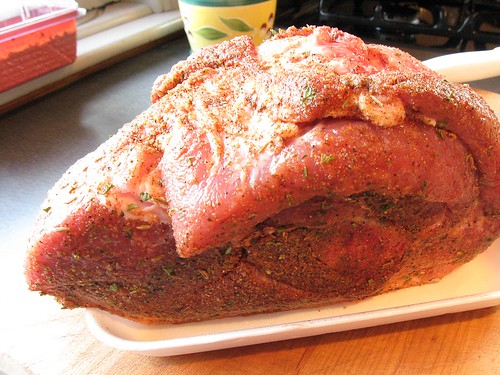
Started with a 4 lb picnic roast. About $5. Picnic is a shoulder cut lower on the shoulder than the Boston butt. It cost about half what a Boston butt costs and the taste is about the same. It's bone in too. I always make pulled from bone-in roasts. Oh, it's also dusted with my basic rib rub.
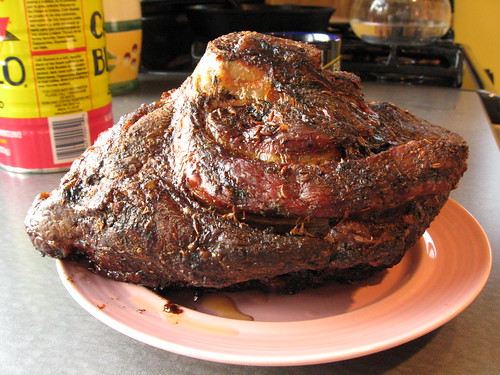
Here's the roast after cooking at 250-deg-F in the oven for 10 hours. It was sitting in rendered pork fat. I saved the pork fat to add dabs in my lentils. The finished product looks very much like a bronzed glorious piece of bacon - only bigger. This was removed from the pool of pork fat and wrapped while I went to the soccer game (Mustangs v. Wizards, tiny tots soccer).
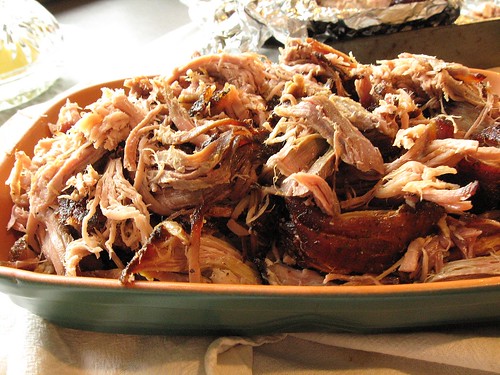
Voila. After it was wrapped and in the fridge a few hours, I warmed it back up until barely warm, unrapped and shredded it effortlessly in my fingers. I must say, it was not smoky but perfect texture and moist. I got about 2 lbs. yield - almost, had a few samples for QC. For a fatty bone-in roast, that was a decent yield. We're having it tonight on wheat rolls (no coleslaw though, darn) with slow cooked black beans and a salad.
4.09.2008
It is NOT time for you to go Grasshopper (Smoked Tofu)
However, once we dust ourselves off and think about it, we're usually glad we did the experiment for the opportunity to modify, learn and to know what not to do so we can keep our friends from getting sick.
I marinated my tofu exactly as in Heidi's recipe, fired up the smoker and layered in a ton of apple wood. Then I tossed on the marinated lumps, closed up the grill and measured temps. I used my new data logger, the EL-USB-TC shown below. It was equipped with a "K"-type thermocouple and placed in the dome beside the thermometer I usually use. Below is an image of the data logger and below that, the corresponding temp profile for the 2 hour smoke.
![smoked tofu [3/5]](http://farm4.static.flickr.com/3220/2401562033_b9e86ce6cb.jpg)
The smoke went for a couple hours with a Tmax just above 300F. I closed the dome vent partially to bring it down and finally lifted the lid after two hours to reveal the final smoked tofu shown in the final image.
My wife and I eagerly placed a tender nugget in our mouths. While in some else's home, no member of our family is allowed to say anything derogatory about food served. But, we were home, and no one was around. It sucked. Bad. Texture was nice, but it sucked.
Post-Mortem
1. The lemon in the marinade clashed badly with the smoke.
2. For some reason, I thought a delicate food like tofu required a strong smoke blast. I couldn't have been more wrong. The opposite is probably more like it.
3. The lemon in the marinade clashed badly with the smoke.
Improvements?
With all the cool monitoring capabilities I now have, I can't stop. I'm considering a soy/sesame oil marinade and a hint of smoke for the next run, but I have lots to think about.
If I were on Top Chef, Padma would've told me to pack my knives.
4.08.2008
Grasshopper, you will know the path when it is right.
I am getting dangerously close to the dark side. Smoked Tofu.
Inspired by Heidi's marinated tofu and my recent experience smoking kielbasa, I'm preparing to try something I haven't observed yet. Application of smoking to explore new fusion cuisine. Tennessee meets Southern China.
I scored some apple smokewood at Weiland's Gourmet Market yesterday, as well as some extra firm tofu. The texture of kielbasa is similar to that of tofu. Fine grind, kind of amorphous, soft. I intend on smoking it for about 1-2 hours with a heavy dose of apple.
My friends on the Weber forum may never reply to my posts again. A risk I'm willing to take to take on new challenges.
4.04.2008
weber_cam will soon be so darn tedious, nobody will visit!
 I've been hunting for an affordable means to measure temperature over time between the range of about rt to about 400-500-deg-F. I have found it! This little baby is selling at MicroDaq for $82 and I jumped on it fast.
I've been hunting for an affordable means to measure temperature over time between the range of about rt to about 400-500-deg-F. I have found it! This little baby is selling at MicroDaq for $82 and I jumped on it fast.
It takes conventional K, J and T thermocouples giving a range of temperature of -200 to about 4,000-deg-F (should be adequate). Acquisition frequency can be adjusted from every second to every 12 hours; it stores zillions of data points. Then, plug it in to a USB port and analyze the smoked pork shoulder goodness like few have ever analyzed it before. I will bring bbq pork to a whole new level. I'm giddy with anticipation.
What am I going to use it for you ask? Long burn bbq runs, warming dough from the fridge to find the perfect temp for proof/baking, determination of exothermicity of fermentation (bread and beer). Yes, this blog, with all 20-something daily visitors should soon turn so tedious, I should be able to diminish my traffic to 5 or so in a month. I can't wait.
I will however have some of the most reproducible, robust processes in all of food preparation/processing. Temp profiles posted after my first pork picnic roast overnight run.
![smoked tofu [2/5]](http://farm4.static.flickr.com/3064/2401561969_b285a05fd2_m.jpg)
![smoked tofu [4/5]](http://farm3.static.flickr.com/2088/2401563139_c628f251a8_m.jpg)
![smoke_temp_tofu [tofu 1/5]](http://farm4.static.flickr.com/3125/2402389766_554b580e76_m.jpg)
![smoked tofu [5/5]](http://farm4.static.flickr.com/3165/2402392308_fb37cdd4e7_m.jpg)
